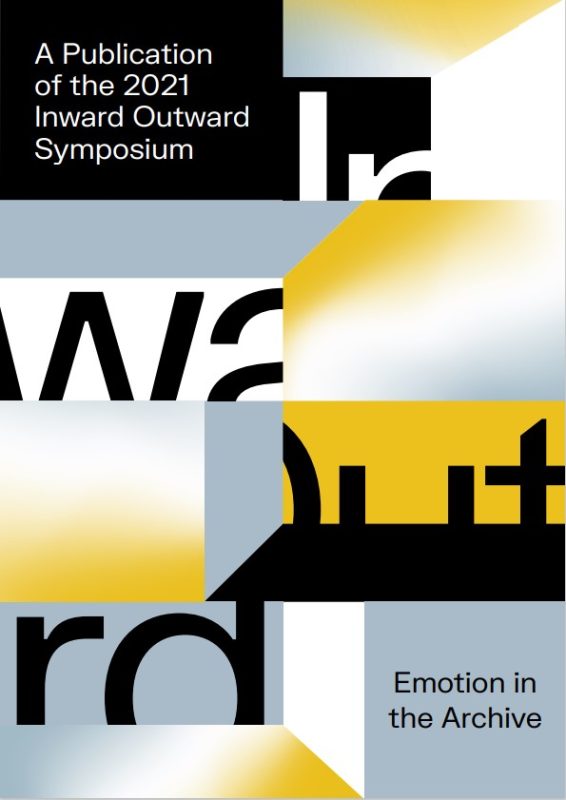06.12.2022
Publication Release – Inward Outward 2021
On October 13–15, 2021, the second edition of the Inward Outward symposium took place online. Initiated between the KITLV and Sound & Vision, and with special support from the RCMC, Inward Outward brought together archival practitioners, artists, academics, and researchers to explore the status of moving image and sound archives as they intertwine with questions of coloniality, identity and race, focusing specifically around the theme of Emotion in the Archive.
Today, we’re proud to release the second Inward Outward publication Emotion in the Archive: A Publication of the 2021 Inward Outward Symposium.
Conceived as a way to further discussions that surfaced during the symposium, this digital publication collects different contributions from the speakers of Inward Outward. Across this publication 12 individual texts unfold, interrogating the interrelation of emotion and archival practices as they intersect with coloniality: Where do we encounter emotions, affects and feelings in the archive? How are these captured in both sounds and moving images and in the practices used to organise the archive? And, most pressingly, how do these emotions inspire us to unlearn and undo the dominant imperial practices and discourses that have determined our work so far?
The publication begins with an abridged version of the symposium’s opening conversation, “Anger and Defiance and the Archive”, in which Amal Alhaag and Teresa Cisneros reflected on feeling everything from rage to boredom to amusement as they work in colonial archives, and what actions they take in response to those emotions.
Inspired by their talk, Stevie Nolten shares a series of questions that probe the nature and detail of “Anger in the Archive”.
Wigbertson Julian Isenia explores transnational dialogues between Black, LGBTQI+ intellectuals in “Love and Compassion amid Many Adversities: On Black, Queer Archival Practices”. In doing so, Julian embraces the often, but not always, contradictory relationships between love, critique and personal and institutional change.
Eliza Steinbock offers contemplations of discomfort by encouraging white readers in particular to lean into difficult emotions in “White Affect Caught in the Colonial Act: The Cultural Archive of Shame and Guilt”.
Mary Huelsbeck shares a description of the Wendy Clark Collection’s Love Tapes, a video art installation, and explores the unique contribution of audio and visual archives to the discussion of emotion.
Centring the body in a dialogue between present and past, Cécile Accilien examines her own body as “a record of practices [and] values that date back centuries” and help her navigate her individual connections to collective history in “My Hair Is My Archive”.
In “Algerian Letters: The Jewellers of the Oumah”, keynote speaker Ariella Aïsha Azoulay ponders whether, when one’s ancestors have been doubly disappeared from colonial archives, it is possible to trace their experiences and existences through their craft and the objects they created.
In “Item Cannot be Displayed: Refusal as a Modality of Care”, Carine Zaayman reflects on the significance of objects and their curation in light of her recent experience of the Jagger Library fire at the University of Cape Town in South Africa. She shows us how these reflections on loss and care resulted in a different kind of intervention during a workshop she facilitated at the symposium, where participants decided not to share the objects they had brought with them to the workshop.
Taking the question of objects from the material to the digital plane, Daniela Agostinho first contemplates her discomfort with being involved in the digitisation process in “Encounters with the Danish Colonial Archive: Affect, Labour and Spaces of Care”; she then seeks insight and inspiration from artist Jeannete Ehlers’s installation Black Is a Beautiful Word. I & I (Encountering the Danish Colonial Archive) which creates context for and dialogue with what had been a static, colonial image.
Imara Limon and Inez van der Scheer explore the reframing of colonially implicated material in an adaptation of their presentation which explored curatorial practice at the Amsterdam Museum and how shame and guilt are connected to a research project and exhibition about the Golden Coach. To think beyond museum collections as they currently exist, they also speak to the museum’s collaborations with artists, asking how critical art practices can interact with museum practices and their collections, while also complicating such relationships.
In “The Museum Visits a Therapist”, visual artists Mirjam Linschooten and Sameer Farooq share images and descriptions of their film of the same name, which explores the similarities and connections between symptoms of and treatment for trauma and the processes by which workers restore colonial-era objects at the Tropenmuseum, the Netherlands’ largest ethnographic museum.
Finally, in “How to Hold an Image”, Jue Yang shares her process of “interrupting the colonial gaze” by contextualising images produced for the Dutch colonial project and juxtaposing them with images of their creators and traces of herself.
We welcome you to download the publication.
If you have any thoughts or reflections in reading this publication we invite you to get in touch with us at: inwardoutward@beeldengeluid.nl
